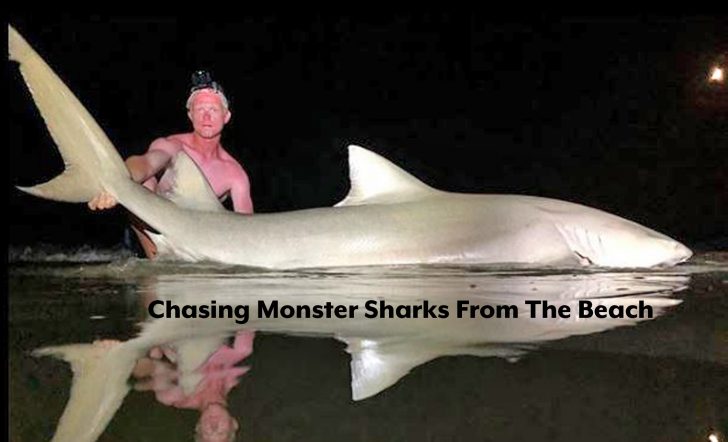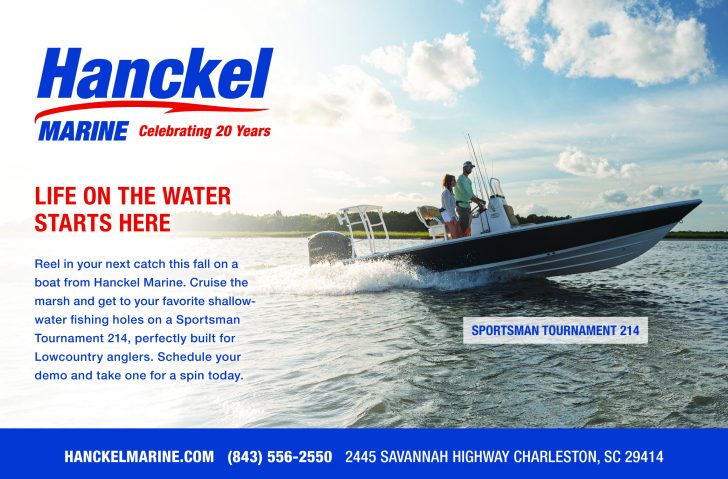Drag peeling, toes dug in the sand, sweat pouring, heart pounding, back muscles screaming. You’ll never feel more alive than when you’re connected to a shark five times your body weight that has no problem letting you know how angry it is about the 20/0 circle hook in its jaw.
This is a common experience for the men of Apex, a small band of land-based shark fishermen based out of Charleston.
The 2020 season has been our best and most adrenaline-filled one yet, with seven land-based hammerheads and four tiger sharks caught on Charleston beaches.
With the privilege of catching such incredible animals comes the responsibility of returning them to the wild, not only for future enjoyment by other anglers but also to allow big sharks to continue functioning as apex predators, a role crucial for maintaining the diverse coastal ecosystem.
The CPR (catch-photograph-release) practice is a staple of land-based shark fishing.
Although some degree of post-release mortality is unfortunately inevitable in any catch and release fishery, the angler can employ certain handling and release practices to improve the overall likelihood of survival.
Targeting the biggest and baddest sharks in our waters requires highly specialized fishing, handling, and release practices to ensure safety for both the fishermen and the sharks themselves.
A standard presentation involves a 20/0 size non-stainless inline circle hook baited with a hefty piece of fish or stingray.
With the privilege of catching such incredible animals comes the responsibility of returning them to the wild
Non-stainless hooks will eventually rust out if left embedded in the animal’s jaw in case they are too deep to remove in a safe or timely manner and require cutting the rig or the hook itself with bolt cutters.
Inline (non-offset) hooks are specifically used to minimize gut hooking. A small section of vinyl coated 400lb cable is crimped to the hook for bite protection and connected to the mainline with 10 to 15 feet of 700lb mono to prevent the fish from wrapping its tail in the rig and cutting the line from the back-and-forth movement of its sandpaper-like skin.
Baits are taken upwards of 400 yards off the beach using a sea kayak and anchored to the sandy ocean floor with a 16oz spider weight, no small feat when less than ideal wind and tide conditions complicate the matter with nasty current and a tricky surf break.
The overall length of the fight time is ultimately one of the most important factors in determining whether or not the shark will survive upon release.
A shorter fight time equates to less energy exerted and higher probability of post-release survival. B
ecause sharks are obligate ram ventilators, they must actively swim in a forward direction in order to force oxygen-rich water over their gills in the correct direction.
Targeting the biggest and baddest sharks in our waters requires highly specialized fishing
Longer fight times have the tendency to drain a shark’s energy to the point where it can no longer move water through its gills on its own.
Therefore, shorter fight times allow a fish to be released with enough energy to recover.
As a result, the standard reel used to target large sharks is an 80-wide conventional, which not only offers enough line capacity to get a bait far enough off the beach while leaving enough on the spool to fight the fish but is also capable of exerting sufficient drag pressure to put the brakes on a large shark.
Heavier drag settings allow the angler to slow, turn, and beach the shark in a shorter amount of time, increasing the shark’s chances of survival.
Proper handling practices are also paramount to ensuring a shark’s survival. When beaching a large shark, the bare minimum equipment includes a de-hooking tool, bolt cutters, wire cutters, and measuring tape.
From the moment the fin breaks the surface, all team members must know exactly what their roles are in beaching and releasing the shark.
Tasks usually include leadering the fish into shallow water, removing the hook from the shark’s jaws (or crunching the hook with bolt cutters if removing the hook is deemed too dangerous for the shark or too time consuming), measuring the shark, snapping a quick picture, and releasing the fish as quickly as possible.
The absence of assigned roles only leads to confusion and longer release times. Care must also be taken to ensure that the shark is not pulled into water that is took shallow.
Big sharks are incredibly heavy and without enough water to support their bodies their internal anatomy can be seriously injured by their own weight.
When done correctly and with the safety of both the shark and the angler firmly in mind, land-based sharking can be one of the most rewarding fishing experiences South Carolina has to offer.
The sport is both physically and mentally arduous, even unforgiving at times, but when you finally get the chance to watch a shark twice your size kick off into the darkness and feel small in and ocean full of monsters, you know you’ve accomplished something.
Stay safe, stay bent!
James Strange – College of Charleston ’20 Marine Biology
Instagram: @james_strange97 @apexsharkfishing
You may also be interested in reading Fishing For Blackfin Tuna
LEAVE YOUR COMMENTS BELOW!








